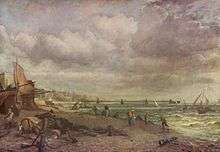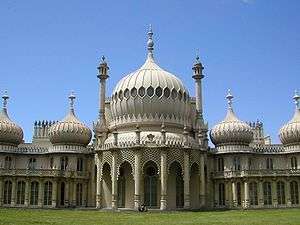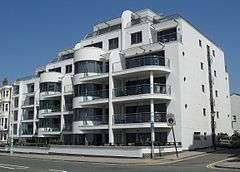Royal Suspension Chain Pier
The Royal Suspension Chain Pier was the first major pier built in Brighton, England. Built in 1823, it was destroyed during a storm in 1896.[1]



History
Generally known as the Chain Pier, it was designed by Captain Samuel Brown rn and built in 1823.[2] Brown had completed the Trinity Chain Pier in Edinburgh in 1821.[3] The pier was primarily intended as a landing stage for packet boats to Dieppe, France, but it also featured a small number of attractions including a camera obscura. An esplanade with an entrance toll-booth controlled access to the pier which was roughly in line with the New Steine. Turner and Constable both made paintings of the pier, King William IV landed on it, and it was even the subject of a song.
The Chain Pier co-existed with the later West Pier, but a condition to build the Palace Pier was that the builders would dismantle the Chain Pier. They were saved this task by a storm which destroyed the already closed and decrepit pier on 4 December 1896.
The remains of some of the pier's oak piles can still be seen at the most extreme low tides. Masonry blocks can also be seen. The entrance kiosks and signal cannon of the pier are still intact, and are now used as small shops on the Palace Pier.
See also
![]()
References
- "Sussex Piers - East Sussex - West Sussex - Ports, Piers - Ferry Photographs - Ferry Postcards". www.simplonpc.co.uk. Retrieved 15 June 2017.
- Drewry, Charles Stewart (1832). A Memoir of Suspension Bridges: Comprising The History Of Their Origin And Progress. London: Longman, Rees, Orme, Brown, Green & Longman. pp. 69–74, Plate V. Retrieved 13 June 2009.
- Skempton, A. W. (2002). A Biographical Dictionary of Civil Engineers in Great Britain and Ireland: 1500–1830. Thomas Telford. pp. 86–87. ISBN 978-0-7277-2939-2.

.jpg)
.jpg)
